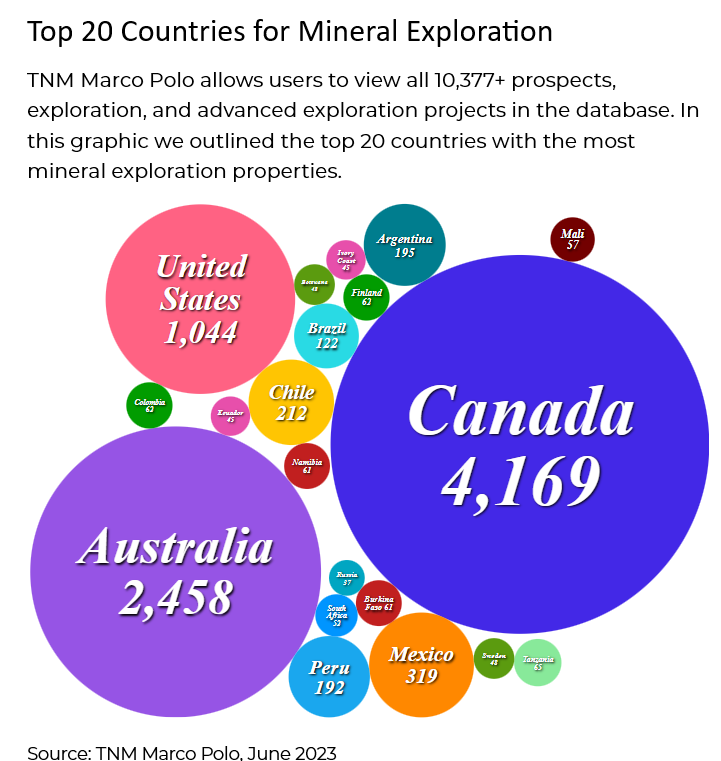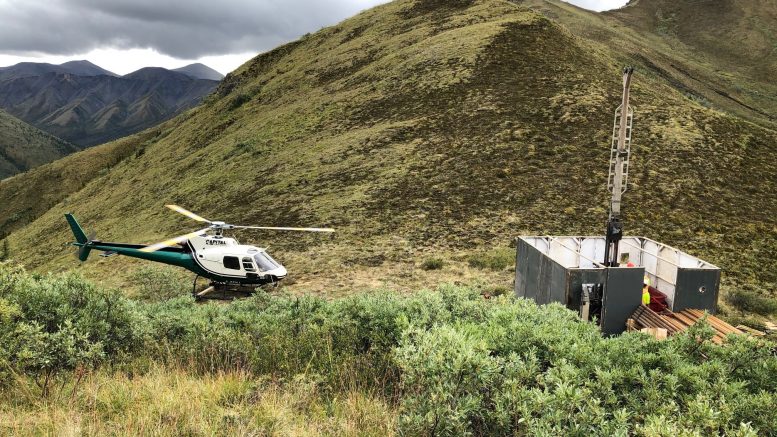The world is working to build an environmentally sustainable future. At the heart of the challenge is a shift away from fossil fuels towards technologies with zero emissions or powered by renewable energy.
These technologies require critical minerals such as lithium, nickel, copper — and much more mining.
According to BloombergNEF, meeting net-zero climate targets requires $10 trillion worth of metals between now and 2050. The demand for these materials is immense, and yet on average it takes 10 to 15 years to go from a discovery project to a producing mine, says Costmine Intelligence VP Michael Sinden.
So who is looking for the minerals now that we will need in the future?
The answer starts with finding accurate data on the next generation of mining projects, which is tracked by TNM Marco Polo’s global database. The graphic below outlines the top 20 countries that lead exploration activity, ranked by total number of projects. All exploration projects from the prospect stage up to advanced exploration are included, using data as of June 2023.

#1 Canada: 4,100+ exploration projects
Canada ranks No. 1, boasting the most exploration projects by far. The country hosts the world’s most active mineral exploration industry with a long history of discovery.
Canada is fertile ground for mineral exploration with many tax incentives available to support companies and a specialized finance industry is geared towards funding early stage projects.
Exploration companies can issue flow-through shares to “flow through” certain expenses and tax credits to the share purchaser. Plus, the recently established mineral exploration tax credit (METC) is designed to help exploration companies raise equity funds for strategic minerals.
#2 Australia: 2,400+ exploration projects
Snapping at the heels of Canada’s mineral exploration dominance is Australia. It is one of the world’s largest untapped minerals markets with 80% of the continent yet to be explored.
World-class mineral deposits have been discovered throughout the Pilbara and Eastern Goldfields in Western Australia, the Gawler Craton in South Australia and the Bowen Basin in Queensland.
Australia’s Junior Minerals Exploration Incentive (JMEI) encourages investment in greenfield exploration. Eligible companies can generate tax credits by choosing to write off a portion of their losses from exploration expenditures.
#3 United States: 1,000+ exploration projects
In third spot, is the United States, which has prospective ground with the largest gold producing jurisdiction in the world, Nevada. As well, Alaska gleams with prospectivity, with projects such as Western Alaska Minerals’ Illinois Creek project enjoying exploration success.
Currently, U.S. President Joe Biden’s administration is focusing on developing domestic sources of critical minerals with a special focus on lithium brine operations. While established environmental and permitting regimes make building a new mine challenging, exploration activity for the next source of domestic critical metals and minerals is picking up.
#4 Mexico: 300+ exploration projects
Mexico has a mining history stretching back 500 years and is among the world’s largest metal producers. It is the largest producer of silver in the world and a top global producer of gold, copper and zinc and it is estimated that there are over 1,100 producing mines.
However, Mexico’s mining body Camimex warned that recent legal reforms to the country’s mining code could jeopardize US$9 billion of investments. The changes make it more difficult for companies to obtain mineral concessions.
Under the new legislation, the Mexican Geological Service would conduct all mining exploration activities.
#5 Chile: 200+ exploration projects
Chile is the world’s top copper producer with 28% of global copper production and the second-largest producer of lithium, with 22% of world production. According to Costmine Intelligence, in 2022, the Chilean mining industry produced 4.9 million tonnes of copper and 395,000 tonnes of lithium.
Chile holds further potential but its government has plans to increase state control over these key commodities. On the horizon is Chile’s law 21420, which is due to take effect in January 2024. The implementation was postponed because of the need to review certain issues relating to the country’s mining concession system.
A world of mining data at your fingertips
TNM Marco Polo offers fast access to data on the next generation of mineral exploration projects. This software relies on an extensive global mining database fuelled by Costmine Intelligence, allowing users to view up-to-date snapshots of over 2,600 mining companies, 13,700+ properties, and 19,600+ executive and management personnel.
Each company profile contains an owned property summary, financials, production volumes, key management personnel and access to the latest news, technical and financial documents.
TNM Marco Polo makes unearthing new opportunities easy, with asset profile pages that include contact details for site-level personnel, commodity exposure and mining and processing technologies in use.
You can discover the next generation of mining on Marco Polo. https://marcopolo.tnm.global/


Be the first to comment on "JV Article: The world’s leading countries for mineral exploration"